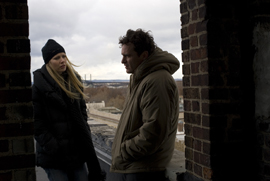
By Elise Nakhnikian
Sunshine Cleaning is so pleased with its own smug noncomformity and sometimes strenuous quirkiness, you’d think it would be painful to watch. Actually, I liked it well enough, thanks to the excellent cast. But the more I think about this paint-by-numbers indie, the less I want to.
As you probably know if you know anything about it at all, Sunshine Cleaning was produced by several of the producers of Little Miss Sunshine – and the similarity doesn’t end with the title.
This time around, another adorable grade-school-age kid, Oscar Lorkowski (Jason Spevack), sets what there is of a plot in motion. Oscar has to leave school because of a string of vaguely defined incidents (It seems he is so very quirky that only his semi-bohemian extended family can appreciate him), so his single mom, Rose (Amy Adams) decides to get a better-paying job so she can send him to private school. Instead of cleaning regular homes, which is what she’d been doing, she starts specializing in ones where someone has died – and enlists her sister to help.
This sets the stage for some odd-couple antics as Rose, the conscientious sister who always worries about what people think, pairs up with the rebel-without-a-cause Norah (Emily Blunt). Rose frets when some of her old high school friends, who used to see her as an equal – or better (she was the head cheerleader -- condescend to her because of her job. But Norah’s not having any of that. “You’re better than they are, Rose,” she says.
The Lorkowski girls’ crusty but loyal father (Alan Arkin) doesn’t care what anyone else thinks either. He’s Oscar’s biggest fan and ally, scoffing at the teachers and principals who can’t see that his grandkid is “an imaginative kid, that’s all!” In short, he’s basically the grandpa from the other Sunshine transplanted into this one. He’s even played by the same actor. (Though to be fair, if you could get Alan Arkin to play that part, would you turn him down?)
The actors really are wonderful. Adams seems skinless as a smiling-through-tears, underappreciated good girl. After her guileless Southern housewife in Junebug and her oppressed junior nun in Doubt, she runs the risk of getting typecast this way. That would be a shame, since she’s got tremendous range – just look at her charmingly sunny ditz in Miss Pettigrew Lives for a Day or her savvy political aide in Charlie Wilson’s War. But she is great at playing soulful vulnerability. When she lets Rose’s humiliation slowly redden her transparent skin or tighten the corners of her mouth, you can’t help but feel her pain.
Blunt is equally moving as the sister who slides through life behind a shield of tough-guy detachment. I could have done without the scene where she goes “trestling,” climbing up beneath an elevated train track to scream and then cry as the train roars by overhead, not just because it feels so contrived but also because Blunt does such a good job of showing us the emotions her character is repressing that we don’t need to see her release them.
There are a lot of teary confrontations and melodramatic moments, most of which you can see barreling toward you, like so many trucks on a desert highway. Rose meets a nice cleaning supplies salesman, Winston (a quietly alert Clifton Collins Jr. in a role that's as truncated as Winston’s amputated arm), who looks like a romantic prospect. Norah becomes embroiled in an ambiguous relationship with Lynn (the endearingly awkward Mary Jane Rajskub), the daughter of a suicide they cleaned up after. Winston bonds with Oscar. A salesman tells Oscar that the CB in the van for their cleaning business transmits “right up to Heaven,” so Rose uses it to have a teary chat with her dead mother. Rose leaves Norah alone on a job, where she messes up in a spectacular way.
The whole thing doesn’t quite hang together, roaring from one episode to the next and finally just stopping rather than reaching a conclusion.
Maybe leaving things unresolved was supposed to be proof of the movie’s indie cred, but I found it frustrating. After all, the point of a movie like this is to empathize with the characters -- and to get a kick out of watching them. Arkin and Adams and Blunt and Collins Jr. made that work, so by the end of the movie, I cared enough about their characters to want to know they’d be okay. Would Rose and that nice Winston get together? Where were Norah and her cat heading off to? And whatever happened with Oscar’s school, anyhow?
On second thought, never mind. I could really care less.















